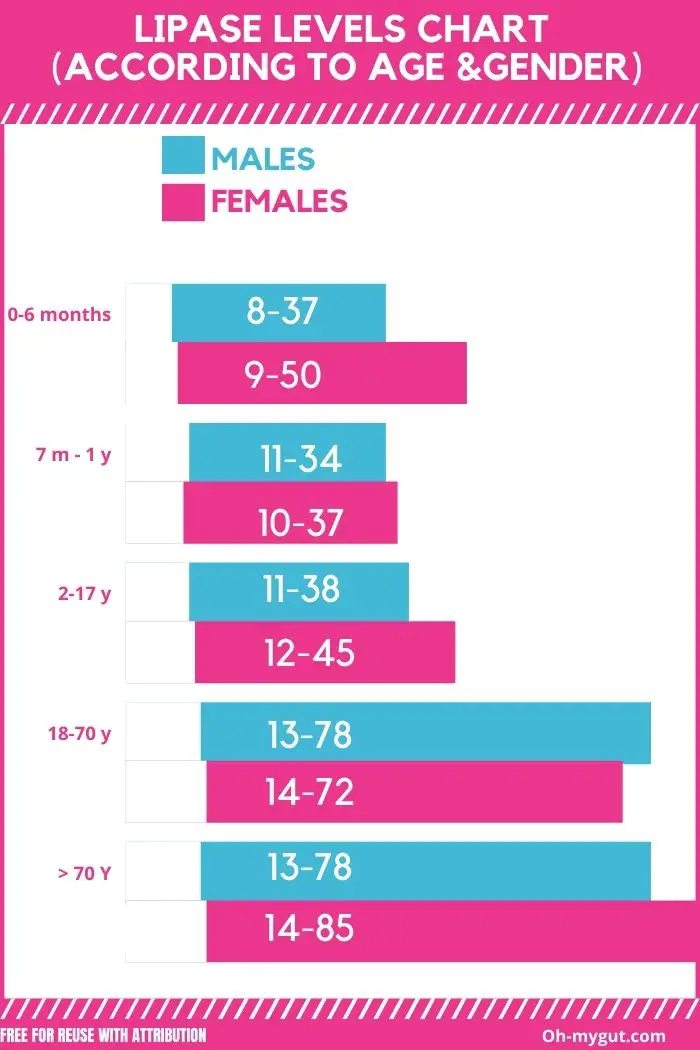Lipase levels 101: Normal ranges, Elevated, Low Levels & More.
Our content is not intended nor recommended as a substitute for medical advice by your doctor. Use for informational purposes only.
Lipase levels normally range from 13 to 78 U/L (units per liter). Acute pancreatitis may be present if the lipase level is more than three times the normal upper limit.
Lipase is a blood test for acute pancreatitis. However, elevated lipase levels don’t always mean pancreatitis.
This is a doctor’s guide for beginners who want to understand lipase levels and their significance.
1. What is lipase in blood work?
Lipase in blood work is a test used to screen for acute pancreatitis. When lipase is more than three times the normal upper limit, your doctor may think you have pancreatitis.
Lipase is a small protein molecule that helps your body digest fats (a digestive enzyme). It is produced mainly by the pancreas to digest the fats you eat.
However, lipase is also present in other sites of your body (in lesser amounts). So, an elevated lipase doesn’t always mean pancreatitis.
Other body tissues that have lipase are:
- Salivary glands.
- The gastrointestinal tract (The intestine, the colon, the liver, and the gallbladder).
- Female reproductive system (the ovaries, uterus, and fallopian tubes).
- Tumor tissues (particularly ovarian, prostate, lung, esophageal, and breast cancers). Also in multiple myeloma and suprarenal gland tumors.
- The brain.
2. Lipase levels in normal range.
Lipase levels differ by age and gender. Normal ranges are often lower in children and females.
Lipase levels’ normal range is typically between 13 and 78 U/l in adult men and between 14 and 72 in adult women.
The levels differ according to age. The chart below illustrates lipase levels’ normal ranges by age.

It is worth mentioning that minor elevations of serum lipase without remarkable symptoms are often due to underlying conditions such as medications and diabetes.
3. Lipase levels high: what does it mean?
Acute pancreatitis, a sudden inflammation of the pancreas, is the most common reason serum lipase is so high. The pancreas is the main site of lipase production.
When there is acute pancreatitis, the lipase enzymes appear in the bloodstream in high concentrations of over 1000, 5000, or even 10,000 U/L.
However, elevated lipase levels don’t always mean acute pancreatitis. Lipase levels may increase with other pancreatic and non-pancreatic conditions.
Common causes of high lipase levels are:
- Acute pancreatitis
- Chronic pancreatitis
- Renal failure
- Acute cholecystitis
- Bowel obstruction or infarction
- Duodenal ulceration
- Pancreatic calculus
- Pancreatic tumors
- Type 2 diabetes mellitus
- Diabetic ketoacidosis
- HIV disease
- HCV infection
- Macrolipasemia
- Post-ERCP/trauma
- Sarcoidosis
- Celiac disease
- Inflammatory bowel disease
- Idiopathic
- Medications:
- Adrenocorticotropic hormone
- Ardeparin
- Cholinergics (e.g., bethanechol)
- Dipeptidyl peptidase-4 (DPP-4) inhibitors
- Fat emulsions
- Furosemide
- Indomethacin
- Methacholine
- Methylprednisolone
- Metronidazole
- Narcotics (e.g., codeine)
- Oral contraceptives
- Pegaspargase
- Pentazocine
- Secretin
- Sulfisoxazole
- Thiazide diuretics
- Triprolidine/pseudoephedrine
- Valproic acid
- Zalcitabine
4. Causes of low lipase levels.
The lower limit of normal lipase lipase in adults is 13 U/L. Lipase levels are considered low in adults if they are 12U/L or less. However, the reference ranges may differ from lab to lab, and it is often lower in children and adolescents.
Common causes of low lipase levels:
- Children and adolescents (lipase may normally be as low as 8 or 9 U/l in infants, children, and adolescents.
- Diabetes mellitus.
- Obesity.
- Metabolic syndrome (hypertension, hyperlipidemia, obesity, DM (insulin resistance), and atherosclerosis).
- Sample correction or lab errors (A second test should confirm low serum lipase).
- Advanced stages of chronic pancreatitis: in such cases, the patient often has severe symptoms such as fatty diarrhea (steatorrhea), weight loss, and malabsorption). See lipase levels in chronic pancreatitis below (section 6).
5. Lipase levels in acute pancreatitis.
The average lipase levels during acute pancreatitis are between 1000 and 10,000 UL. The elevation of serum lipase does not correlate to the severity of pancreatitis (reference).
However, some other studies showed that elevated lipase levels of more than 600 U/L (within 24 hours of symptoms or presentation) might indicate severe pancreatitis.
Here are some interesting facts about lipase levels in acute pancreatitis:
- The lipase levels start to rise within 4-8 hours of the onset of symptoms.
- The peak levels are often at 24 hours from the onset of symptoms of acute pancreatitis.
- The lipase levels don’t return to their normal range until 8 to 14 days pass.
- Lipase levels rise earlier and last longer than amylase, so it is more useful in acute pancreatitis.
- However, non-specific elevations (even to very high levels) may occur without pancreatitis, as with renal failure, duodenal ulcers, inflammatory bowel disease, etc.).
Can lipase levels be normal in a patient with acute pancreatitis?
Yes, lipase levels can be normal in some cases of acute pancreatitis. For pancreatitis to be diagnosed, you need to have at le**ast two of the following**: an elevated lipase level, an image of the abdomen that looks like pancreatitis, or typical pancreatic pain.
So, a patient can be diagnosed with acute pancreatitis if there are:
- NORMAL serum lipase levels.
- AND typical pancreatic pain (epigastric, referred to the midback, severe, constant, and partially improved by leaning forward).
- AND a radiological feature suggestive of acute pancreatitis (by abdominal ultrasound, CT, or MRI).
6. Lipase levels in chronic pancreatitis.
Chronic pancreatitis is a long-term disease in which the pancreatic tissue is always inflamed and damaged. It often occurs as repeated attacks of acute inflammation. Over time, the pancreatic tissue becomes damaged from losing its function.
The lipase levels are not diagnostic for chronic pancreatitis. Lipase levels can be normal, elevated, or decreased depending on the stage of the disease.
For instance:
- During attacks of inflammation, the lipase levels may be elevated in chronic pancreatitis, reaching more than the three-times the upper limit of normal.
- In between the attacks, the levels may be normal or mildly elevated.
- In long-lasting chronic pancreatitis, lipase levels may become low due to the loss of lipase-producing pancreatic tissue (due to fibrosis).
So, your doctor cannot depend on lipase levels to diagnose chronic pancreatitis. Instead, he frequently conducts other investigations, such as:
- A thorough history taking to identify symptoms suggestive of chronic pancreatitis (repeated previous attacks of acute pancreatitis, chronic diarrhea, weight loss, or diabetes.
- High-resolution CT or MRI (especially MRCP type).
- Pancreatic function tests, such as the secretin test.
- Endoscopic ultrasound.
7. Lipase levels are slightly elevated; when should I be concerned?
The pancreas is not the only source of elevated lipase levels.
The pancreas does not also secrete lipase. It is also found in other places in your body, such as salivary glands, the stomach, the intestines, the liver, the gallbladder, the brain, and female pelvic organs.
Also, lipase is secreted in certain breast, ovarian, prostate, and multiple myeloma tumors.
So, slightly elevated lipase levels can be due to either pancreatic or non-pancreatic causes.
There is no universal definition of “slight” elevation of lipase levels. As doctors, most of us consider lipase levels below the three-time upper limit of normal a slight elevation.
Possible causes of slightly or mildly elevated lipase are:
A. Pancreatic causes of slightly elevated serum lipase.
- Alcoholic pancreatitis (some cases).
- Late presentation of acute pancreatitis.
- Acute on top of chronic pancreatitis.
- Trauma to the pancreas (for example, in road traffic accidents).
- Post-ERCP (endoscopic retrograde cholangiopancreatography).
- Post-pancreatic surgery.
- Pancreatic cancer.
- Cystic fibrosis.
- Complications of pancreatitis after the attack (as pancreatic pseudocyst).
- Stones in the pancreatic duct.
B. Extrapancreatic causes of a slightly elevated lipase:
Several conditions may lead to a slight elevation in serum lipase. Common examples include:
- Acute cholecystitis.
- Bowel obstruction or infarction.
- Duodenal ulcers.
- Type 2 diabetes mellitus.
- Diabetic ketoacidosis.
- HIV disease.
- HCV (hepatitis C virus) infection.
- Sarcoidosis.
- Celiac disease.
- Inflammatory bowel disease (Crohn’s disease and ulcerative colitis).
- Macrolipasemia (presence of lipase with an abnormally large molecular size).
- Critical illness.
C. Decreased elimination of lipase from the body.
In kidney diseases, your body may not get rid of lipase properly. So, a slight elevation in serum lipase may occur in patients with chronic kidney disease.
D. Drugs that cause elevated lipase:
The drugs that cause elevated lipase levels are illustrated in the table below.
| Adrenocorticotropic hormone |
| Ardeparin |
Cholinergics (e.g., bethanechol) |
Dipeptidyl peptidase-4 (DPP-4) inhibitors |
| Fat emulsions |
| Furosemide |
| Indomethacin |
| Methacholine |
| Methylprednisolone |
| Metronidazole |
| Narcotics (e.g., codeine) |
| Oral contraceptives |
| Pegaspargase |
| Pentazocine |
| Secretin |
| Sulfisoxazole |
| Thiazide diuretics |
| Triprolidine/pseudoephedrine |
| Valproic acid |
| Zalcitabine |
E. Idiopathic mildly elevated serum lipase.
In many cases (particularly when abdominal pain is absent), no cause for elevated lipase could be identified.
- Evidence-based
- Written by a doctor.











